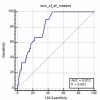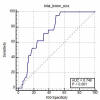A retrospective review of MRI features associated with metastasis-free survival in women with breast cancer: focusing on skin thickening and skin enhancement
- PMID: 34591686
- PMCID: PMC8631024
- DOI: 10.1259/bjr.20210472
A retrospective review of MRI features associated with metastasis-free survival in women with breast cancer: focusing on skin thickening and skin enhancement
Abstract
Objectives: To identify associations between MRI-detected skin thickening and enhancement and metastasis-free survival (MFS) given recent reports of skin thickening on ultrasound being a poorer prognostic indicator.
Methods: Interrogation of a prospectively collected database of ultrasound-visible breast lesions showed 214 lesions with pre-treatment MRIs available for analysis in a single centre. Data on MFS was prospectively collected. Retrospective MRI review was performed blinded to outcome. Imaging factors recorded were presence of skin thickening and enhancement, non-mass-enhancement (NME) and abnormal nodes, mass characteristics, perilesional oedema and background parenchymal enhancement. Statistical analysis used chi-squared test, Kaplan-Meier survival curves, the Log-rank test and receiver-operator characteristic (ROC) curves.
Results: During a median follow-up period of 5.6 years, 21 (10%) of 212 patients developed distant metastases. Skin thickening [24 of 30 (80%) vs 169 of 184 (92%), p = 0.043] and skin enhancement [15 of 20 (75%) vs 178 of 194 (92%), p = 0.016] were associated with poorer MFS. Large index lesion size [p < 0.001, AUC 0.823], large sum of masses [p < 0.001, AUC 0.813], increasing total lesion extent including NME [p < 0.001, AUC 0.749] and abnormal axillary nodes [55 of 66 (83%) vs 138 of 148 (93%), p = 0.024] were also associated with poorer MFS.
Conclusions: Skin thickening and enhancement on breast MRI are associated with poorer MFS. These findings should be taken into account when managing patients with invasive breast cancer.
Advances in knowledge: Skin enhancement on breast MRI at diagnosis is associated with metastases development. Skin thickening on breast MRI is associated with future metastatic disease.
Figures







References
MeSH terms
LinkOut - more resources
Full Text Sources
Medical

